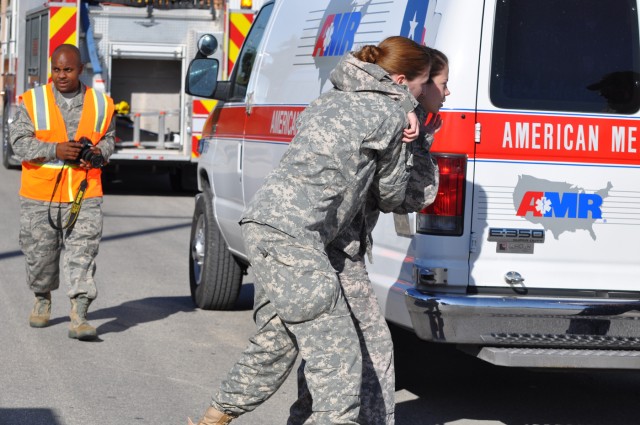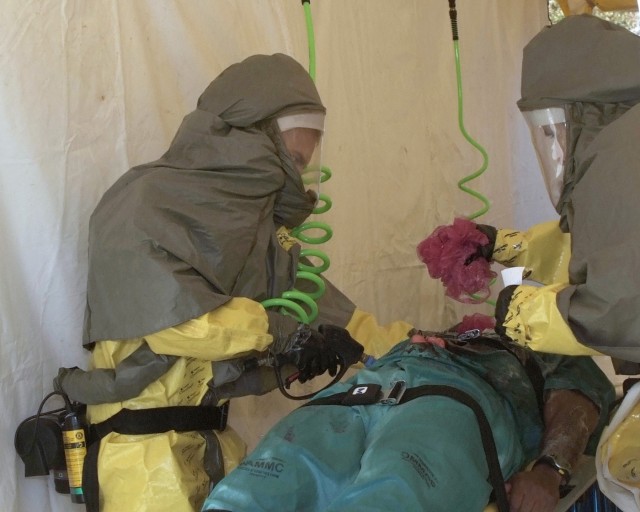FORT SAM HOUSTON, Texas -- Every day we are faced with images and stories about violent crime. Victims are held hostage, shootings happen in supermarkets, schools and even on secure military installations.
According to data from the Federal Bureau of Investigation, there were more than 9,100 homicides from firearms in the U.S. in 2009.
"One of the roles of the 502nd Air Base Wing (ABW) and the 502nd Mission Support Group (MSG) is to ensure the force protection of Fort Sam Houston and its people," said Col. Mary Garr, 502nd MSG commander.
"A current risk across our military is that of an active shooter lashing out for whatever reason. We need to be prepared to stop one and to prevent/minimize risk to the people on the installation," Garr explained.
In an effort to improve and sustain 502nd ABW emergency management policies and procedures, a massive Active Shooter Exercise was held on post Nov. 17.
About 250 personnel participated in the exercise.
"We have been training personnel across Fort Sam Houston on how to react as individuals, and we are also training on how to conduct an installation response to an active shooter," Garr said.
During the exercise scenario, a disgruntled employee gained access to the post, entered Building 3663 and took 32 hostages.
Approximately 11 minutes later, he began shooting hostages. One hostage escaped from the building and alerted the police.
At this point, 502nd Security Force Squadron personnel and Brooke Army Medical Center (BAMC) security guards entered the building and killed the shooter, but he'd released a canister of tear gas leaving three of the four officers incapacitated.
The officer who escaped the tear gas called a recovery team to secure the building.
"We closed gates, secured areas and worked with different mission partners. We really exercised a lot of Security Forces Squadron functions including communication," said Steve Kampman, training supervisor, 502nd Security Forces Squadron.
"This was a great building block to see where we have to improve on some issues and where we really met some goals."
As access control points were locked down and a perimeter established, the Crisis Action Team (CAT) was notified and the Emergency Operations Center (EOC) and an Incident Command Post (ICP) were established simultaneously.
The CAT consisted of the 502nd ABW commander and key elements of his staff, the 502nd MSG commander and emergency managers who were positioned at the EOC.
The assistant fire chief took charge of the ICP, which was positioned close to the scene, but out of harm's way.
"Even though I wasn't in view of the actual operation, my crew chiefs were on scene feeding me all the pertinent information I needed to know," said Assistant Fire Chief Terry Davis.
"I communicated with the EOC to pass information onto the command staff. Everyone was kept informed about what was happening on the scene. Communication was key," Davis said.
Once the building was secure, the fire department entered the building in full protective gear.
After the site was declared safe, fire personnel and security forces began evaluating victims' injures and evacuating the building. Patients were then loaded into waiting ambulances and buses and transported to BAMC for decontamination and treatment.
Eighteen evaluators closely monitored the exercise looking at the processes of establishing a perimeter, neutralizing the threat, establishing personnel at the site, communication and whether National Incident Management System guidelines were being followed.
Safety was also an important exercise management consideration.
The lead exercise site evaluator, Eric Ruggs, assistant chief of training for the Fort Sam Houston Fire Department, was responsible for the exercise operations at the incident site, including the safety of personnel participating.
"Being lead site evaluator gave me a new perspective, because I'm used to evaluating from solely a firefighter perspective," Ruggs said.
"We looked at how well we notified first responders and base populace; and how well initial and follow-on responses and recovery actions were accomplished," explained Henry King, chief, Exercise Evaluation Team for the 502nd ABW.
"It was a very positive exercise. We have some lessons learned, but that's with any exercise. We are going to have more exercises with BAMC and other mission partners," King said.
"This exercise tested our new command and control relationships and showed us where we need to tighten up our processes," Garr said. "We identified and met the objectives we set for this exercise and identified where we need to improve for the future."
Related Links:
Fort Hood Internal Review Report (.pdf download)






Social Sharing